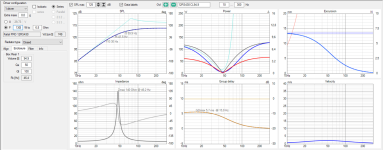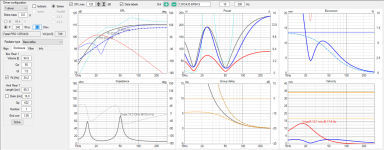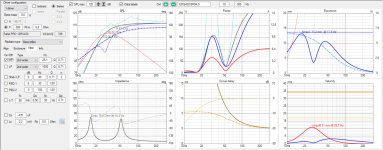Therefore it's best to tune a filtered bass reflex system very low and equalize the falling slope. An eventual added high pass with the resulting group delay could then be below all useful music frequencies.
Edit:
And with all this filtering and equalizing it may be questionable why not go for a sealed, equalized system with just a bit more Sd ...
Another thought about vented box group delay: Adding a high pass filter below the vent tuning frequency makes the group delay worse. Much worse as a matter of fact.
I'm sure you all have simulated this stuff but here for othersGroup delay for the vented box is greater than for the closed box, but only for the octave above Fb. Since the audibilty of group delay below 40 Hz is not proven, I'll take the hit in exchange for all the benefits.
Another driver faitalpro 12rs430 in closed box, and in ported box with and without high pass. I cannot make the ported box not to exceed xmax and be louder than the closed box without high pass filter. Unless, there is assumption that say below 20Hz there is no musical content and one is willing to buy new driver should it break, then high pass filter might not be necessary. Ported and very low tuned box exceeds xmax on very low frequency and resulting group delay around 100Hz and even below is similar to closed box.
Here is the closed box, auto calculated by VCAD.

Same size ported box, lot's more output extracted with more amplifier power, but without high pass filter excursion skyrockets. This is adjusted here so that xmax is crossed about at 20Hz. Group delay is similar to closed box down to say 50Hz.

To protect the driver, high pass filter makes the group delay bit worse, but even more output can be xtracted with power. The driver should not annihilate when dropping the needle, or a mic.

If one builds box like this there is lots of options to tune the sound. The port could be blocked to get performance of closed box. Using an EQ the room modal peaks can be controlled and balance of system tuned. One could listen whether the port should be open or blocked, which ever sounds better. If mo output is needed use it ported, engage high pass filter for party and movies. If there is enough power perhaps best is to leave it closed and EQ to taste.
YesI like tuning vented boxes lower than most, not for maximum flatness but more for closeness to the response of a closed box with equivalent volume. For example, an RSS460 in 4 ft^3 (110 litres) will be tuned to Fb = 19 Hz with an f6 of about 24 Hz or so, not far from what a closed box gets. However, the same output requires about 3 dB less drive in the bottom octave (the midband is unaffected, of course), and the cone excursion is reduced a useful amount for the octave above and the half octave below Fb. Since Fb is ridiculously low, even the pedal tone in Also Sprach Zarathustra doesn't bother the woofer much.
Doesn't deliberately tuning low and thus incurring early rolloff go against the maximum flatness principle of vented boxes? In isolation, sure. However, reasonably sized real rooms tend to have increasing gain below 70-100 Hz, to the point where most, perhaps all, of the rolloff is compensated by room gain, leading to effectively flat response at the listening chair.
Group delay for the vented box is greater than for the closed box, but only for the octave above Fb. Since the audibilty of group delay below 40 Hz is not proven, I'll take the hit in exchange for all the benefits.
Very smart
More cone control and when actual bass is added with normal EQ
it does not have the port sound, and all the bass is there.
Finally someone gets it.
Almost like -3 dB and -6dB bass shelfs
People blow a whistle and huff n puff about them.
But when you actually get bass from EQ again.
It doesnt boost and bloom as much into the port.
Both are minimum phase system so theoretically you can EQ a ported speaker to sealed response to get the same group delay behavior.
Dan Cyr demonstrated how group delay smear the wave packet in a paper. The sealed box is no doubt the best case for home audio if DSP/amplifier power is available.
The paper on DIYRM
Dan Cyr demonstrated how group delay smear the wave packet in a paper. The sealed box is no doubt the best case for home audio if DSP/amplifier power is available.
The paper on DIYRM
Interesting points you raised.but combined group delay alone does not characterize the separate arrival times of the driver and port output.
In the first image the direct radiator appears to have negative group delay, can you help me understand that?
I disagree. Vent output is not delayed, it is only phase shifted. Resonance happens according to standard minimum phase expectation for a fourth order high pass filter.The drawback of the resonant reinforcement is time smearing, the vent output augments the driver’s output by adding a "resonant tail" to it.
Yes.Both are minimum phase system so theoretically you can EQ a ported speaker to sealed response to get the same group delay behavior.
Yes and you can do it passively with a 'underdamped' refelx enclosure. Drop the volume and tune very low. Has some caveat with the port lengths etc.Both are minimum phase system so theoretically you can EQ a ported speaker to sealed response to get the same group delay behavior.
Dan Cyr demonstrated how group delay smear the wave packet in a paper. The sealed box is no doubt the best case for home audio if DSP/amplifier power is available.
The paper on DIYRM
Combine it with a HP, and you can have the reduced excursion through the whole audio band.
And if you EQ the normal" reflex to have the same output below tuning your excursion still goes up.
No free lunches anywhere
Discussion sounds very theoretical... So far no-one has mentioned port leaking 400-900Hz which is very common. This can often be seen also in horizontal response spectrograms and distortion.
Small port puffs also more with higher spl (air velocity), it has extremely low area compared to dtiver(s). Passive radiators have more area and general rule is to double them! How often do yu see such large ports? Transmission lines are somwhere in-between but must have huge boxes, not very practical.
Nowdays we have dsp and high efficience classD amps, so for diy active closed speakers or at least bass is the only reasonable solution IMO. Commercial passives are only for dummies who don't understand anything about loudspeakers... Well, most active small monitors are still BR like Genelec and Neumann
Small port puffs also more with higher spl (air velocity), it has extremely low area compared to dtiver(s). Passive radiators have more area and general rule is to double them! How often do yu see such large ports? Transmission lines are somwhere in-between but must have huge boxes, not very practical.
Nowdays we have dsp and high efficience classD amps, so for diy active closed speakers or at least bass is the only reasonable solution IMO. Commercial passives are only for dummies who don't understand anything about loudspeakers... Well, most active small monitors are still BR like Genelec and Neumann
I was thinking the same, but I'd like to see it in real life. I am planning, when time permits to have a mic on the woofer and the port simultaneously and look at the waveforms at the beginning of a sinewave. I'll share here when I get around to it. Kind of like what Alpha Sound did here -I disagree. Vent output is not delayed, it is only phase shifted. Resonance happens according to standard minimum phase expectation for a fourth order high pass filter.
Thanks. I had run some sims with the Dayton RSS265HF-4 and SB34NRXL75-8, but I was busy yesterday so i could not post any graphics...I'm sure you all have simulated this stuff but here for others
I have always wondered how real is the typical presentation of summed nearfield spl's ot the direct radiator and port. And how do they sum if port is on front vs, backside of he box...
I'm not satisfied with the answer that phase difference doesn't matter with low freq. And the port has always output above tuning F too!
Amis shows both nearfield and NFS measurements! A BR with fronfiring ports JBL https://www.audiosciencereview.com/forum/index.php?threads/jbl-4309-review-speaker.27255/
I'm not satisfied with the answer that phase difference doesn't matter with low freq. And the port has always output above tuning F too!
Amis shows both nearfield and NFS measurements! A BR with fronfiring ports JBL https://www.audiosciencereview.com/forum/index.php?threads/jbl-4309-review-speaker.27255/
Last edited:
No way! No speaker + enclosure is so tight that slow athmospheric pressure changes do anything. Sorry but - less theory, more real speaker building.Changes in temperature and barometric pressure with a sealed box driver leads to coil offsets.
That's a huge simplification!For a given woofer Vd (cone area x linear excursion), and all else being equal, a vented box system has 3 dB more SPL capability than does a sealed box system.
At the resonance frequency gains can be up to 10dB! Here the max SPL level of the same 12" driver:
And frequency response:
up to 9dB more (which in reality I never was able to achieve, but 7-8dB is possible.)
BUT - look at the frequencies where we need most power for listening to music - around 60Hz. Max SPL is nearly identical, no real gain for the ported speaker. In the same volume or even less you could put in 2 of these drivers! (That's what I do) Then you have way more SPL in the area you need it and more at very low frequencies.
A big benefit of closed woofers is that you can EQ and adapt them to your room nearly as much as you want. And the fall of often fits the room gain, so you need less correction. You can't do so with ported woofers - you have to protect them for frequencies lower as the resonance frequency and get very steep roll offs with big group delay times.
And now show the same measurement with a 40Hz signalHere is a comparison of the same driver in a closed and ported box with the same strength 80 hz drive signal. The ported system clearly has lower distortion and noise as well as about 6dB more output at the tuning freq.The difference is not subtle.
View attachment 1309958
Of course does the port help arpund the resonance frequency - but ONLY around the resonance frequency! Doesn't do anything above and it's horrible below without protection filter.
Yes, look at the responses of the woofers, they are vibrating at every octave. 40hz, 80hz, 160hz, 320hz, … They are ringing like bells! In a properly built properly damped enclosure the ringing should be very much reduced. The enclosures should be built from solid materials, braced, and stuffed with fiberglass or wool.Can you explain what you mean? I'm not sure how damping is related here?
Either one of those speakers would be unacceptable regardless of the enclosure.
That's a huge simplification!
Yes it is, but I got the math wrong... see post #7
https://www.diyaudio.com/community/...ox-woofers-out-of-fashion.412687/post-7682370
We all stand on the shoulders of people like Olson, Thiele or Small… but we also know the substitution schemes only apply to small signal work as electrodynamic transducers aren’t linear. Everything shifts when you crank’em up. Pro sound designers just pick the driver, build the enclosure, using ballpark figures, and equalize the result, I once was told. I think they might be right regarding the low end.Regarding the theory that a bass reflex system is a minimum phase 4th order filter: Is this an empirically proven fact, or is it a simplifying assumption that was made to enable modeling?
Guys, we are comparing apples to rutabagas. Speaker drivers are built for use with defined performance perameters. Manufacturers don’t produce loudspeakers with random specifications, they build them for use in certain enclosures, with power and output requirements. They have a performance envelope. As the OP has pointed out sealed enclosures have gone out of favor lately due to the ‘big magnet crowd‘ and the ‘vented has more bass crowd’. When neither rule of thumb has much to do with actual bass performance.
I’m a sealed sub guy because it‘s response matches room gain and keeps the one note bass at bay. I have some Econowave two way speakers that do quite well except for the last octave, and they are punchy like the OP asked. I also have some 4” TangBangers in a TLine that go lower than the 12” in the Econowaves, they are not punchy at all but for some reason do pipe organ very well. The 12” in my Ewaves are 93db, my 12” sub is 89 as are my Tlines. The Ewaves CAN’T reproduce the bass frequencies at any volume that my sub can. The Tlines can’t keep up with either as far as output goes, but they sound really good playing jazz. So, I guess my point here is there are different loudspeaker drivers for different purposes. We should be comparing two systems not one specific driver in two alignments.
I’m a sealed sub guy because it‘s response matches room gain and keeps the one note bass at bay. I have some Econowave two way speakers that do quite well except for the last octave, and they are punchy like the OP asked. I also have some 4” TangBangers in a TLine that go lower than the 12” in the Econowaves, they are not punchy at all but for some reason do pipe organ very well. The 12” in my Ewaves are 93db, my 12” sub is 89 as are my Tlines. The Ewaves CAN’T reproduce the bass frequencies at any volume that my sub can. The Tlines can’t keep up with either as far as output goes, but they sound really good playing jazz. So, I guess my point here is there are different loudspeaker drivers for different purposes. We should be comparing two systems not one specific driver in two alignments.
- Home
- Loudspeakers
- Multi-Way
- Why are sealed box woofers out of fashion